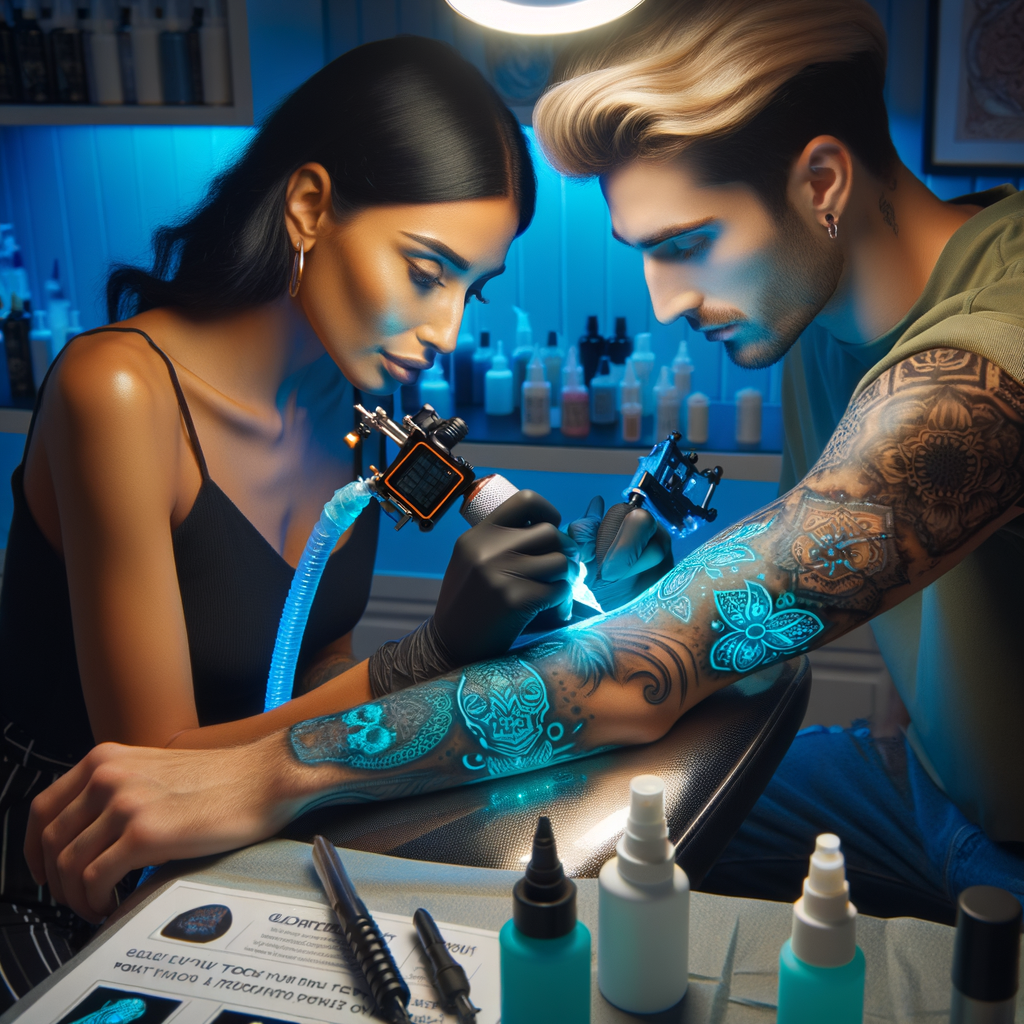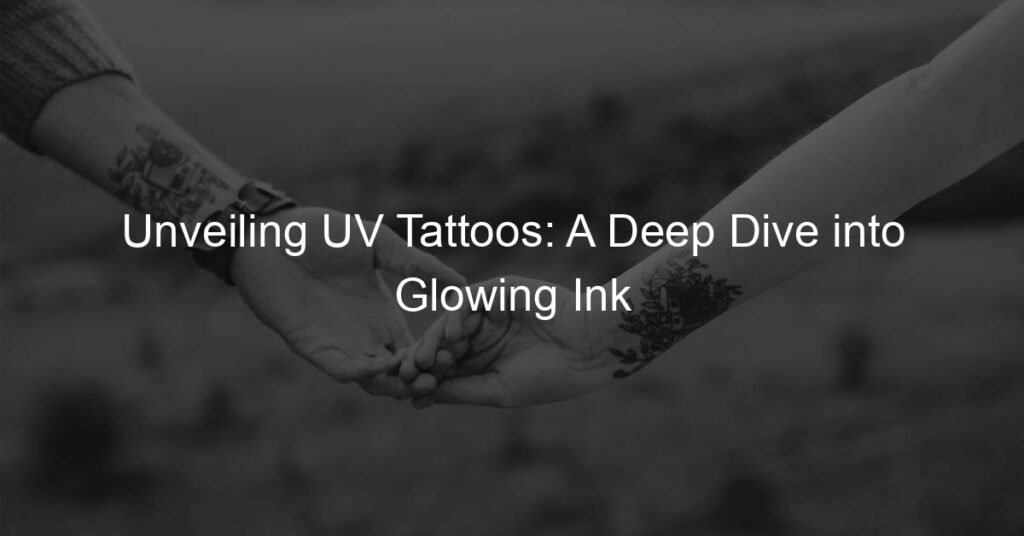
Introduction to UV Tattoos
UV tattoos, also known as ultraviolet or glow-in-the-dark tattoos, have become a unique trend in the world of body art. This introductory guide will help you understand what UV tattoos are, their history, and their current popularity and trends.
-
Understanding UV Tattoos
UV tattoos are a type of body art that uses a special type of ink, visible under ultraviolet (UV) light. This ink is nearly invisible in normal light, making the tattoo a hidden piece of art that comes to life under UV light. The effect is a glowing tattoo, often in colors like white, blue, or green.
UV tattoos can be a full design or used to highlight parts of a regular tattoo. They offer a unique and personal way to express oneself through body art.
-
History of UV Tattoos
The use of UV ink for tattoos started in the late 1990s. It was initially popular in the rave culture, where black lights are common. Over time, UV tattoos have gained wider acceptance and popularity, moving beyond the rave scene to the mainstream tattoo community.
Despite their relatively recent origin, UV tattoos have a rich history of innovation and artistic exploration, with artists continually pushing the boundaries of what is possible with this unique form of body art.
-
Popularity and Trends of UV Tattoos
UV tattoos have seen a surge in popularity in recent years. This can be attributed to their unique aesthetic appeal and the element of surprise they bring. They are particularly popular among younger generations who appreciate the novelty and individuality that UV tattoos offer.
Some current trends in UV tattoos include minimalist designs, hidden messages, and using UV ink to enhance traditional tattoos. As more people discover the possibilities of UV tattoos, these trends are likely to continue evolving.
UV Tattoo Insights
UV tattoos, also known as ultraviolet or glow-in-the-dark tattoos, have a unique appeal. They are invisible in normal light but glow under blacklight. This unique feature makes them a popular choice for those seeking a distinctive body art. Let’s delve into the process of getting a UV tattoo.
UV Tattoo Process
The UV tattoo process is quite similar to that of a regular tattoo, but with a few key differences. Here are the three main steps:
-
- Preparation for a UV tattoo
Before getting a UV tattoo, it’s important to do your research. Find a reputable tattoo artist who has experience with UV ink. Make sure the tattoo studio follows all health and safety guidelines. It’s also crucial to understand that UV tattoos may not be as visible as regular tattoos in normal light.
-
- Process of getting a UV tattoo
The process of getting a UV tattoo is similar to that of a regular tattoo. The artist will first sketch your chosen design on your skin. Then, they will use a special UV tattoo ink to trace the design. This ink is visible under blacklight. The process can take anywhere from a few minutes to several hours, depending on the complexity of the design.
-
- Post-tattoo process
After getting a UV tattoo, it’s important to take proper care of it. Keep the tattoo clean and moisturized. Avoid exposing it to sunlight as UV rays can fade the ink. It’s also recommended to check your tattoo under a blacklight periodically to ensure the ink is still glowing.
Understanding the UV tattoo process can help you make an informed decision about whether this type of body art is right for you. Remember, it’s always important to consult with a professional tattoo artist before making your decision.
UV Tattoo Designs
UV tattoos, also known as ultraviolet or glow-in-the-dark tattoos, are a unique and eye-catching form of body art. The designs are as varied and unique as the individuals who choose to get them. Let’s explore some popular UV tattoo designs, how to choose the right one for you, and ways to customize your UV tattoo design.
-
- Popular UV Tattoo Designs
UV tattoos can be as simple or as intricate as you desire. Some popular designs include celestial bodies like stars and planets, floral patterns, geometric shapes, and even quotes or words. These designs are often chosen for their ability to glow brightly under UV light, creating a stunning visual effect.
-
- Choosing the Right UV Tattoo Design
Choosing the right UV tattoo design is a personal decision that should reflect your individuality and style. Consider factors such as the size and location of the tattoo, as well as how it will look both in daylight and under UV light. It’s also important to consider the longevity of the design, as UV tattoos can fade over time. Consulting with a professional tattoo artist can provide valuable insights and guidance in making your decision.
-
- Customizing Your UV Tattoo Design
One of the exciting aspects of UV tattoos is the ability to customize your design. This can be done by incorporating elements of traditional tattoo designs, using different colors of UV ink, or even combining UV and regular ink for a multi-dimensional effect. Remember, your tattoo is a reflection of you, so don’t be afraid to get creative and express yourself!
In conclusion, UV tattoo designs offer a unique and exciting way to express your individuality through body art. Whether you choose a popular design or create a custom piece, the end result is sure to be a conversation starter. Remember to consult with a professional tattoo artist to ensure the best possible outcome and care for your UV tattoo.
Glowing Ink Tattoos
One of the most fascinating trends in the world of tattoos is the use of glowing ink. This unique type of tattoo ink illuminates under ultraviolet (UV) light, creating a stunning and eye-catching effect. Let’s delve deeper into understanding this intriguing ink.
Understanding Glowing Ink
Glowing ink, also known as UV or blacklight ink, has a special quality that sets it apart from regular tattoo ink. But what exactly makes it glow? What are the different types of glowing ink? And how long does the glow last? Let’s explore these questions.
- What makes the ink glow: The secret behind the glow of UV ink lies in its composition. This type of ink contains phosphors – a substance that emits light when exposed to UV light. When UV light hits a tattoo made with glowing ink, the phosphors in the ink absorb the light and then re-emit it, creating a glow.
- Different types of glowing ink: There are two main types of glowing ink – invisible and colored. Invisible UV ink is transparent under normal light and only becomes visible under UV light. On the other hand, colored UV ink has a faint color under normal light but glows brightly under UV light. The choice between the two depends on the desired effect and personal preference.
- How long does the glow last: The glow of a UV tattoo is not permanent. The duration of the glow depends on several factors, including the quality of the ink, the skill of the tattoo artist, and how well the tattoo is cared for. However, typically, the glow can last anywhere from a few years to several decades.
Understanding the nature of glowing ink can help you make an informed decision if you’re considering getting a UV tattoo. Remember, while glowing ink tattoos can be a fun and unique way to express yourself, it’s essential to understand the process and potential risks involved.
Glowing Tattoos Vs Regular Tattoos
When it comes to tattoos, there are many options to choose from. Two popular choices are glowing tattoos and regular tattoos. Let’s compare these two types of tattoos in terms of their process, aftercare, and longevity.
-
- Comparison of Process
Regular tattoos are created using a tattoo machine that inserts ink into the skin. The artist uses a handheld machine with needles to puncture the skin and inject ink into the dermis, the second layer of skin. This process can take anywhere from a few minutes to several hours, depending on the size and complexity of the design.
Glowing tattoos, on the other hand, use a special type of ink that glows under ultraviolet (UV) light. This ink is injected into the skin in the same way as regular tattoo ink. However, the artist must work under UV light to see the ink and ensure the design is correct. This can make the process a bit longer and more complex than a regular tattoo.
-
- Comparison of Aftercare
Aftercare for regular tattoos involves keeping the tattoo clean and moisturized, avoiding sun exposure, and refraining from picking at the tattoo as it heals. This process usually takes about two weeks.
Aftercare for glowing tattoos is similar, but there are a few additional steps. Because the ink is sensitive to light, it’s important to avoid direct sunlight and tanning beds for a few weeks after getting the tattoo. Additionally, some people may need to use a special lotion to help the tattoo glow.
-
- Comparison of Longevity
Regular tattoos are permanent and will last a lifetime, though they may fade over time due to sun exposure and the body’s natural healing process.
Glowing tattoos, however, may not last as long. The glow-in-the-dark ink can fade more quickly than regular ink, especially with frequent exposure to UV light. However, with proper care, a glowing tattoo can still last many years.
In conclusion, both glowing and regular tattoos have their own unique processes, aftercare requirements, and longevity. The choice between the two depends on personal preference and lifestyle.
UV Ink Safety
UV ink, also known as ultraviolet ink, is a type of ink that glows under UV light. While it can create stunning and unique tattoos, it’s essential to understand the potential health risks and safety measures associated with its use.
-
Health Risks Associated with UV Ink
UV ink can pose several health risks. Some people may experience skin irritation, allergic reactions, or even skin infections after getting a UV tattoo. In some cases, UV ink has been linked to skin cancer. It’s crucial to discuss these risks with a professional tattoo artist or a healthcare provider before deciding to get a UV tattoo.
-
How to Ensure UV Ink Safety
Ensuring UV ink safety involves several steps. First, always choose a reputable tattoo artist who uses high-quality UV ink. Second, follow all aftercare instructions to prevent infection. Finally, monitor the tattooed area for any signs of irritation or abnormal reactions. If you notice anything unusual, seek medical attention immediately.
-
Case Studies on UV Ink Safety
Several case studies have explored the safety of UV ink. For example, a study published in the Journal of Dermatology found that out of 92 participants with UV tattoos, 10% experienced adverse reactions. These reactions ranged from mild skin irritation to severe allergic reactions. This study highlights the importance of understanding the potential risks before getting a UV tattoo.
In conclusion, while UV tattoos can be visually striking, they also come with potential health risks. It’s important to make an informed decision and take all necessary safety precautions when considering a UV tattoo.
UV Tattoo Care
UV tattoos, also known as glow-in-the-dark tattoos, require special care to maintain their unique glow. This care can be divided into two categories: immediate aftercare and long-term aftercare. Let’s delve into these two categories and discuss common issues and solutions.
UV Tattoo Aftercare
Proper aftercare is crucial for the longevity and vibrancy of your UV tattoo. Here are some steps to follow:
- Immediate AftercareImmediately after getting your UV tattoo, it’s essential to keep the area clean and moisturized. Use a mild, unscented soap to gently clean the tattooed area. Avoid soaking the tattoo in water and stay away from swimming pools, hot tubs, and the beach for at least two weeks. Apply a thin layer of tattoo aftercare cream or lotion as recommended by your tattoo artist.
- Long-term AftercareLong-term care for your UV tattoo involves protecting it from sun exposure. UV rays can fade the tattoo and reduce its glow. Always apply a high SPF sunscreen on your tattoo before stepping out in the sun. Also, keep your skin hydrated by drinking plenty of water and using a good quality moisturizer.
- Common Issues and SolutionsCommon issues with UV tattoos include fading and skin irritation. If your tattoo starts to fade, consider getting a touch-up from a professional. If you experience skin irritation, it could be due to an allergic reaction to the UV ink. In such cases, consult a dermatologist immediately.
Remember, the key to maintaining a vibrant UV tattoo is regular care and protection. Follow these aftercare steps to enjoy your glowing tattoo for years to come.
Preserving the Glow of UV Tattoos
UV tattoos are a unique form of body art that glow under ultraviolet light. But, to keep that glow vibrant and fresh, it’s essential to follow certain care tips. Let’s delve into some of the best practices to maintain the glow, products to avoid, and the need for regular touch-ups.
-
- Tips to Maintain the Glow
UV tattoos require special care to maintain their glow. First, always apply a high-SPF sunscreen before exposing your tattoo to sunlight. Sunlight can fade the UV ink over time, reducing its glow. Second, keep your skin hydrated. Dry skin can dull the glow of your UV tattoo. Use a moisturizer that is free of harsh chemicals and fragrances. Lastly, avoid excessive scrubbing or exfoliation of the tattooed area to prevent the UV ink from fading.
-
- Products to Avoid
Not all skincare products are safe for UV tattoos. Avoid using products that contain alcohol, as they can dry out your skin and fade the tattoo. Also, steer clear of products with harsh chemicals, such as bleach or ammonia, as they can damage the UV ink. It’s best to use natural or tattoo-specific products to keep your skin healthy and your tattoo vibrant.
-
- Regular Touch-Up Needs
Even with proper care, UV tattoos may require regular touch-ups to keep their glow. The frequency of touch-ups depends on various factors, including the quality of the initial tattoo, your skin type, and how well you care for your tattoo. On average, you might need a touch-up every 5 to 10 years. Always go to a professional tattoo artist for touch-ups to ensure the best results.
In conclusion, preserving the glow of your UV tattoo involves proper care, using the right products, and getting regular touch-ups. By following these tips, you can enjoy your glowing body art for many years to come.
UV Tattoo Risks
UV tattoos, also known as glow-in-the-dark tattoos, are a unique and exciting form of body art. However, like all types of tattoos, they come with their own set of risks and complications. It’s important to understand these risks before deciding to get a UV tattoo.
-
- Potential Risks and Complications
UV tattoos use a special type of ink that reacts to ultraviolet light, causing the tattoo to glow. However, this ink can potentially cause skin irritation and allergic reactions. Some people may also experience skin discoloration or scarring. In rare cases, the UV ink can interfere with medical imaging tests like MRIs.
-
- How to Mitigate These Risks
There are several steps you can take to reduce the risks associated with UV tattoos. First, always choose a reputable tattoo artist who uses high-quality UV ink. Second, follow all aftercare instructions to prevent infection and promote healing. Finally, protect your tattoo from excessive sun exposure, which can cause the UV ink to fade or change color.
-
- When to Seek Medical Attention
If you experience severe pain, swelling, redness, or pus around your UV tattoo, it’s important to seek medical attention immediately. These could be signs of an infection, which needs to be treated promptly to prevent serious complications. Also, if you notice any changes in the color or appearance of your UV tattoo, it’s a good idea to consult a dermatologist.
In conclusion, while UV tattoos can be a fun and unique way to express yourself, it’s crucial to be aware of the potential risks and take steps to mitigate them. Always consult with a professional tattoo artist and follow their advice to ensure your tattoo experience is safe and enjoyable.
Conclusion
In this article, we’ve explored the fascinating world of UV tattoos. Now, let’s summarize the key takeaways and look towards the future of this unique form of body art.
-
- Key takeaways about UV tattoos
UV tattoos, also known as glow-in-the-dark tattoos, use a special ink that is visible under ultraviolet light. They offer a unique and creative way to express oneself, providing a hidden design that comes to life in certain lighting conditions. However, they also come with risks. The safety of UV ink is still under debate, with some studies suggesting potential health concerns. Moreover, UV tattoos require special care to maintain their glow and prevent skin damage.
-
- Future of UV tattoos
The future of UV tattoos is promising but uncertain. As technology advances, we may see improvements in the safety and longevity of UV inks. However, until more research is conducted, it’s crucial for individuals to fully understand the potential risks and care requirements before deciding to get a UV tattoo. As always, consulting with a professional tattoo artist is the best way to make an informed decision.
In conclusion, UV tattoos are an exciting development in the world of body art, offering a unique way for individuals to express their creativity. However, like all forms of body modification, they should be approached with caution and a thorough understanding of the potential risks and rewards.






